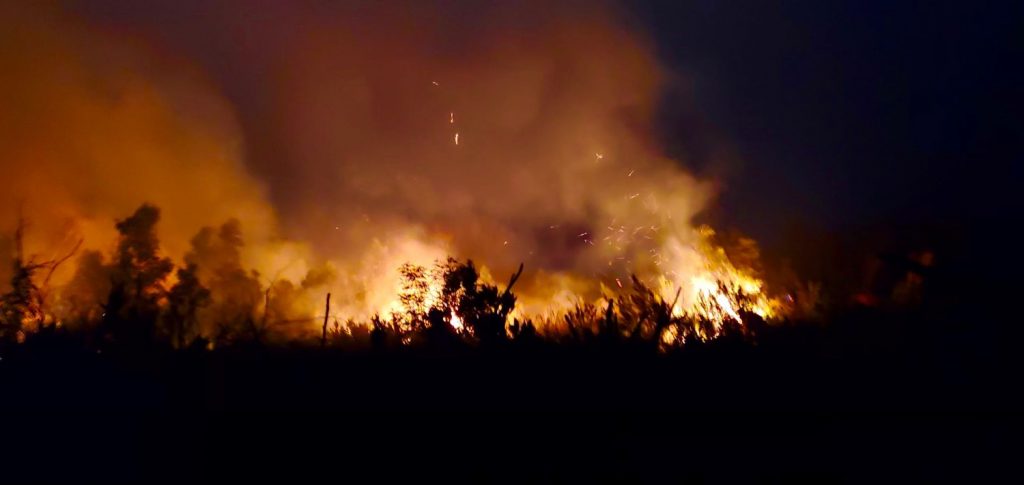Red Flag Warning Over, But Dry Conditions to Persist

Leeward portions of the state, including on the Big Island, remained under a red flag warning through most of Monday, Aug. 1, as fire weather conditions persisted.
A lack of rain, warmer temperatures and an increase in trade wind strength fueled dry conditions and low humidity this past weekend, which resulted in the red flag warning. A wind advisory was also in effect for part of the weekend for portions of the Big Island and other parts of the state.
While both advisories either ended or were canceled by Monday night, Kevin Kodama, a senior hydrologist with the National Weather Service in Honolulu, said Monday that a trend of drier weather throughout the islands will probably continue through the rest of summer and into fall.
Leeward areas of the state, especially the lower slopes, are at most risk of fire weather, according to Kodama. The Humu‘ula Saddle region of the Big Island is also prone to extreme fire conditions.
“Tropical cyclones, or their remnants, could provide some relief, but it is not possible to know for sure if/when these may come through,” Kodama said.
Below normal precipitation is favored for the Hawaiian Islands in August, according to the NWS Climate Prediction Center. Drought also looks to persist in several parts of the state. That could mean an increased risk of wildfires.


“Wildfires occur on every island, on both windward and leeward sides, especially during drought episodes like the one projected for the next few months,” Andrea “Nani” Barretto, co-executive director of the Hawai‘i Wildfire Management Organization, told Big Island Now on Monday in an email.
Hawai‘i Fire Department Deputy Fire Chief Eric Moller said the threat of wildfires is a real concern.
“Wildfires are experienced year-round and occur on a regular basis,” Moller told Big Island Now on Monday in an email, adding most are caused by human activity. “The leeward side of the island has the greatest frequency of fires due to the relative dry conditions and light, flashy fuels.”
There have been several brush fires this year on the Big Island, and Hawai‘i Volcanoes National Park recently experienced a wildfire on the slopes of Mauna Loa. Historically, Moller said, the island has seen many fires that have consumed more than 1,000 acres. The largest wildfire in recent history was the Mana Road fire in 2021, which consumed more than 40,000 acres and destroyed two structures.
And while some only last a few days, many, such as the Honu‘apo fire in Ka‘ū, can last months.
“When the fire gets underground, it can burn organic material in a layer called the ‘duff.'” Moller said. “This layer can spread fires beyond fire breaks and cause secondary fires to sprout well beyond the control lines.”
Wildfires are dangerous to the people living or visiting the places where they occur, but there also are numerous hazards for the firefighters who battle them beyond the fire itself and the smoke it produces.

“The terrain in which these fires take hold is treacherous and difficult to move in,” Moller said. “Open lava tubes and cervices are normally obscured with vegetation. This poses a fall hazard for firefighting personnel as well as mechanized equipment. It also limits the ability to evacuate if conditions become untenable.”
He said the hazards of wildfires also can be experienced well after the blaze. Moller said dust can obscure driving conditions on roads. It can even make it into the ocean, killing coral reefs.
In addition to those hazards, the deputy fire chief said the work required to extinguish wildfires is back-breaking and arduous.
“Even the best conditioned firefighters can be taxed by these activities,” Moller said. “Additionally, it is easy to step into pockets of fire burning underground. Recently, one of our firefighters stepped into one of these pockets and received third-degree burns to her leg.”
A Kaua‘i firefighter was also recently injured while fighting a brush fire in Kealia.
“The important thing to remember about wildfires is that they are different than other natural hazard events in that they can be prevented and their impacts reduced if we are proactive,” Barretto said. She added firefighting is the last line of defense — everyone doing their part ahead of time is the best way to prevent these types of fires.
“Did you know 99% of fires are caused by people, many of them by accident, so don’t be the cause,” Barretto said.
There is a lot people can do, individually and collectively, to protect homes, families and communities from wildfire.
“And now is the time to take action and be wildfire-aware,” Barretto said.
She offered these wildfire prevention tips:
- Don’t pull over on dry grass, wait for a paved or gravel pullout. Don’t use equipment that sparks in dry areas or on windy days.
- Make and practice a family emergency plan. Include neighbors who might need help.
- Since fires can only travel where there is fuel, keep grass short and trees trimmed high. Clean leaf piles around your home, yard and rain gutters. Anywhere wind blows leaves, it can blow embers.
- Get involved in your community’s efforts to reduce fire hazards in and around your neighborhoods. Click here to learn more about the Hawai‘i Firewise Communities program to get started.
Moller said it boils down to preparation.
“The best way to deal with wildfire is to prevent it in the first place,” he said. “A close second would be to have preventive measures in place.”
For more information and tips to prepare for and prevent wildfires, Barretto and Moller encourage people to visit the Hawaiʻi Wildfire Management Organization website.
“We want our islands to be wildfire-ready and wildfire-safe, and it’s going to take all of us (to) get there,” Barretto said.






